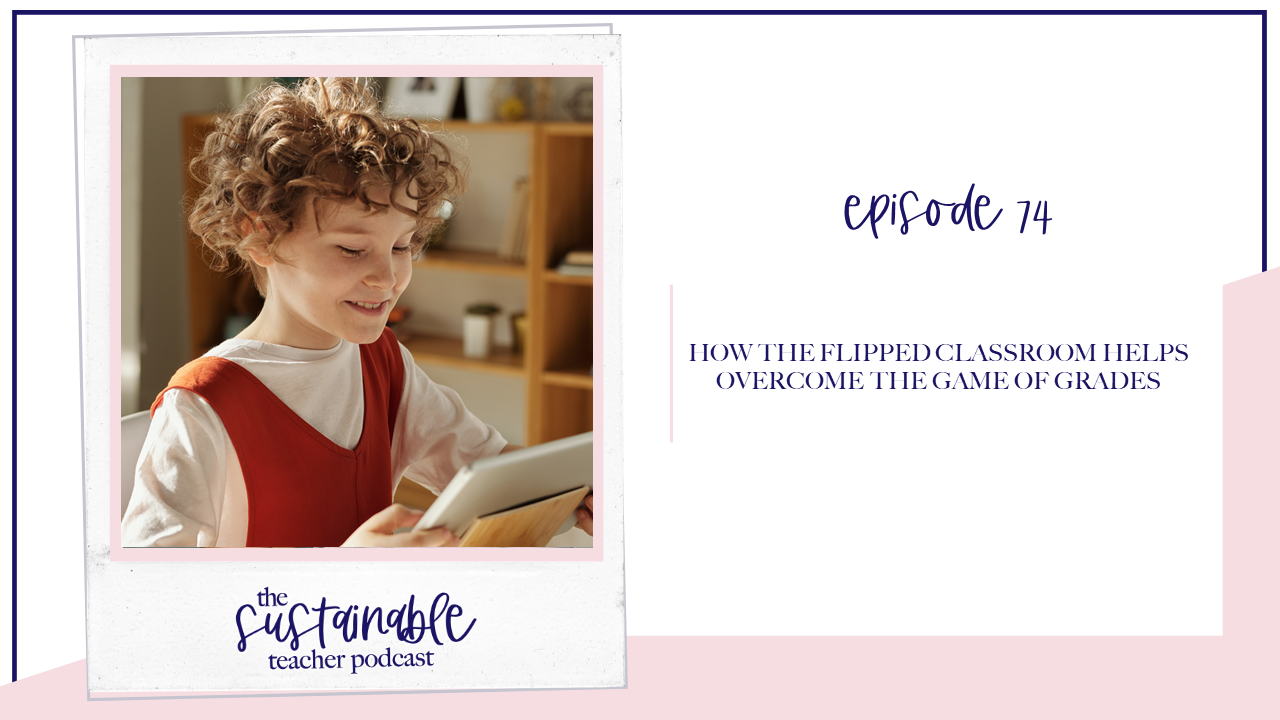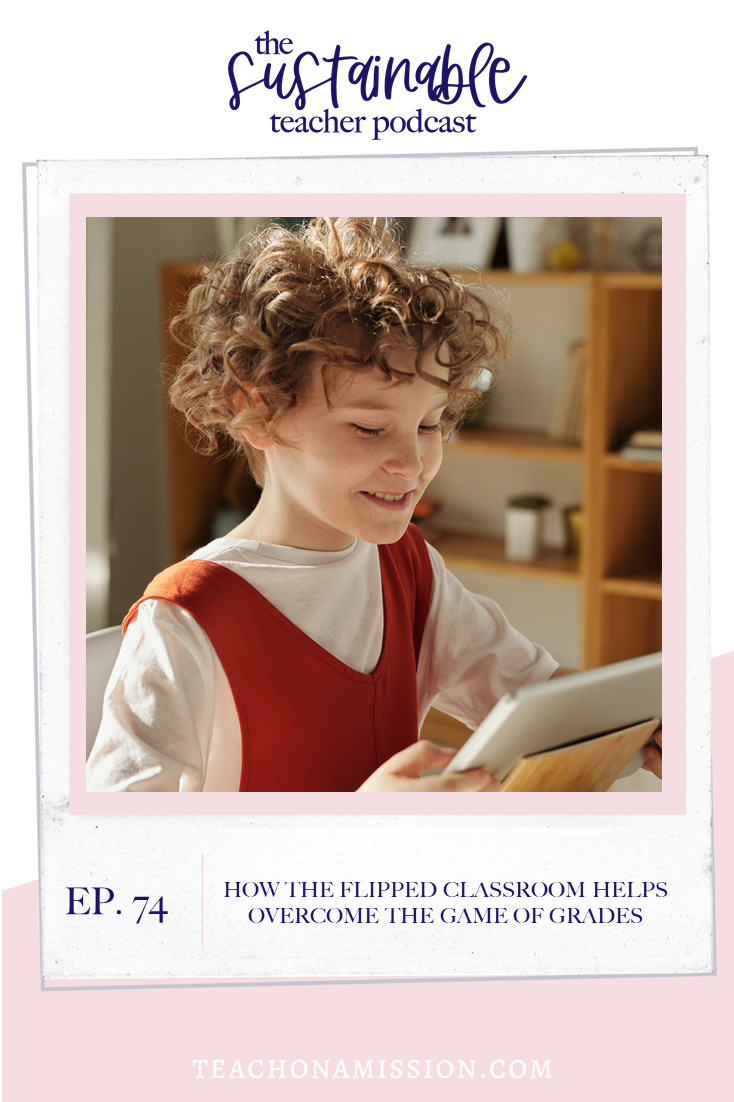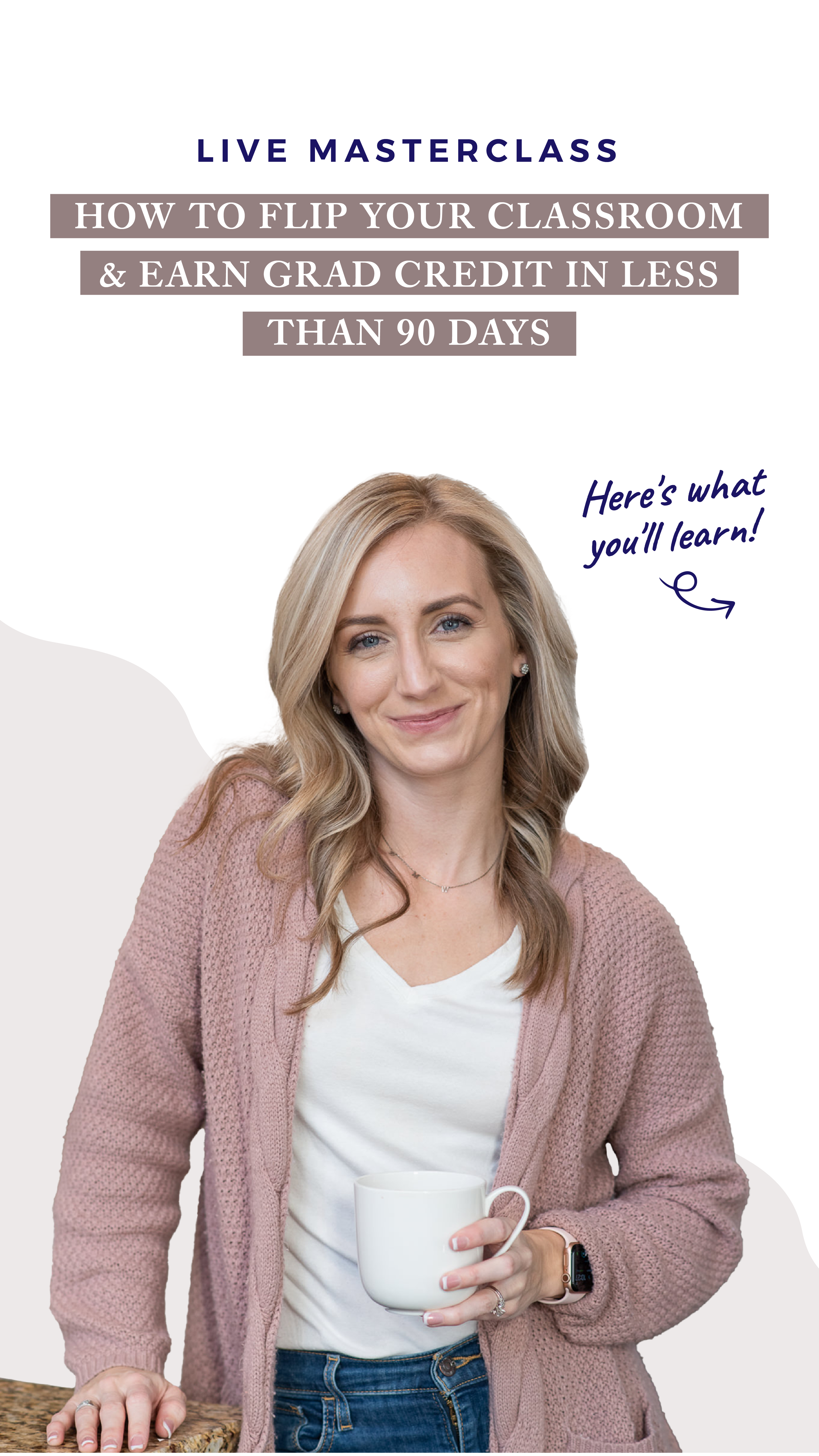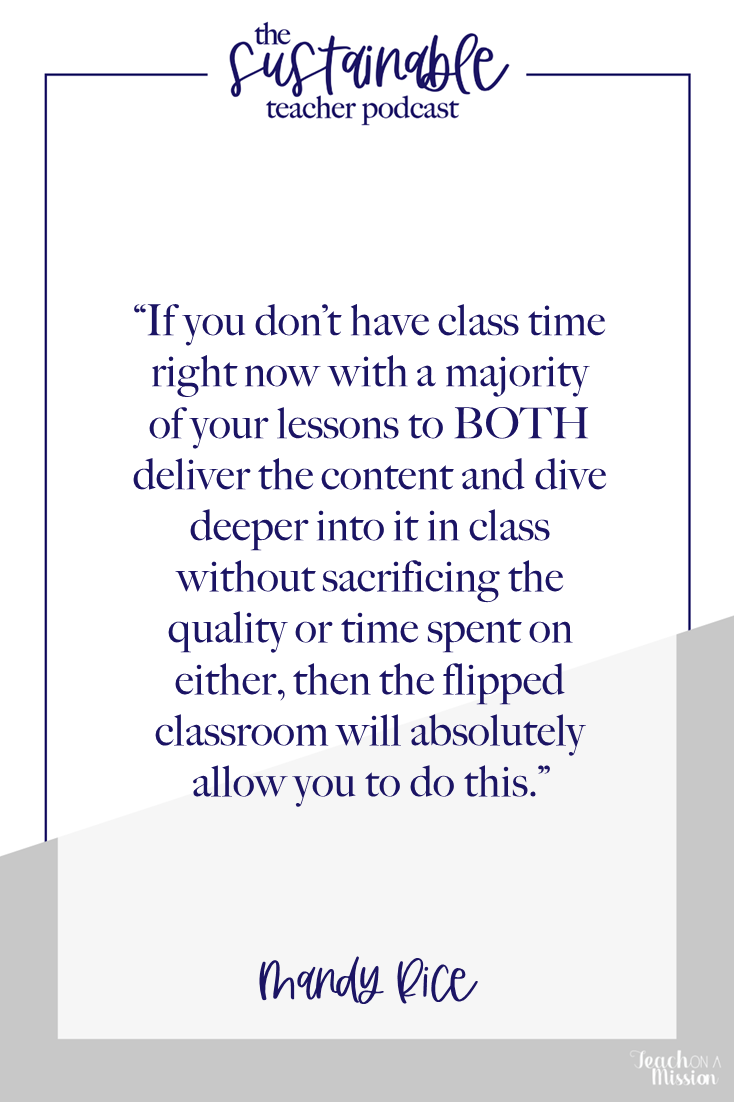How Flipping Your Classroom Helps Overcome the Game of Grades

Oh, the game of grades. It’s the toxic consumption of our students' attention only on what grade they are paid with for every little move they make in your classroom rather than on the experience of learning that happens in their brain while a student of yours.
It’s as if you have to pay your students in the currency of grades for any “work” they do in your class, otherwise it won’t get done. As if the work getting done is the goal - NO! It’s not! The learning that happens while doing the work is the goal, and yet our students can’t take their focus away from the work.
So how do overcome this game of grades? How do we make the focus of our classroom on the learning that happens rather than the “work” that leads to grades?
I’ve actually addressed this topic already in episode 30 titled Overcoming the Game of Grades with Your Students. So that episode is very much a precursor to this one. Although it’s not required to listen to episode 30 before proceeding with this one, it’s definitely an episode you want to select “play next” on. I’ve linked episode 30 below in the description of this episode so you can check it out.
This episode is going to focus on how the flipped classroom specifically can help you overcome the game of grades with your students.
In fact, after listening to this episode you will have a laser sharp depiction of what the flipped classroom will do for your classroom culture and the performance of your students because of how it shifts the focus away from grades and onto the learning itself.
I’ll discuss the various aspects of the flipped classroom that you’ll implement when you’re ready to start your flipping journey, and how you’ll see that work pay off as a result in your students’ focus on learning rather than on grades.
If this episode topic is intriguing to you, I would so appreciate you click to share the episode with your teacher-friends. Send it in a text or email, post a screenshot on social media tagging me as @teachonamission, and I so appreciate you helping us get our message of sustainability into the ears of teachers craving to get back to the manageable career they love.
Ok, let’s get to it.

How To Flip Your Classroom and Earn Grad Credit in Less Than 90 Days
Before we get to today’s episode, I have an opportunity I must share with you, and here it is. After spending 10+ years flipping my classroom, and reaping the benefits for my professional and personal life, I built a one-hour professional development training program that provides you the path to reap the same benefits in your own classroom and personal life.
And it’s available now for registration. It’s called, How to Flip Your Classroom and Earn Graduate Credit in Less Than 90 Days, and it will be a great training on how to Plan, Build, and Implement a Thriving Flipped Classroom with the guidance of someone who’s done it before so that you hit the ground running and don’t have to sacrifice your evenings and weekends in the process!
When you click below to get registered, you can choose the date and time that works best for you - I’m offering 4 LIVE sessions - then I’ll send you confirmation and the pd workbook straight to your inbox. So mark your calendars, and I’ll see you there live for flipped classroom training and free resources. Get registered today at teachonamission.com/pd.
Now let’s get back to our episode.
How Flipping Your Classroom Helps Overcome the Game of Grades
If you’ve taught for less than one school year, I’m sure you have felt the pain of the game of grades. I remember specifically a conversation with one of my former students and his parents when I decided to no longer give points for reading guides, but instead incentivized them in other ways (for instance, surprising students with the chance to use reading guides on a quiz, things like that).
The parents' concern was that my lack of giving a grade for this assignment did not reflect the real world. He said that when his son goes into the workforce, he will be directly paid via his salary for his hard work.
And that’s when a lightbulb went off for me - my students, and in this case one of their parents, saw grades as a form of payment for their work in my classroom. As if coming to school and doing what I asked inside the learning experience I created was equivalent to clocking in and doing a days’ for wages. As if my students were factory workers and I the factory manager.
Here’s the problem with that - I don’t get paid as a factory manager. I don’t mean that our salaries aren’t equal, I mean that I do not get paid for my “factory workers’” performance. Sure I get to keep my job if I’m effective with my students, but I certainly do no get paid more when my factory workers, I’m sorry, students are doing a great job.
In keeping with this analogy, what this parent was also saying is that doing the work in my classroom was equivalent to assembling something in a factory, rather than the fact that it’s more reflective of the training the factory worker went through in order to start that job. And if they didn’t pay attention, learn, and ultimately pass the training, they never would have the job in the first place.
So, no, my students are not factory workers. And their work is different from that of someone on the job.
And my classroom absolutely contributed to the shift that happened in my students who were slowly but surely, throughout any given school year, able to focus on the learning happening inside their brains rather than only on the grades they received. Their vision and perception of school was less clouded by the game of grades, and their grades improved because of it.
So what I’ll do here is take you through the various aspects of my classroom, and how it resulted in that less clouded vision, and a clearer understanding and focus on the learning process.
Flipped Videos
The best known aspect of the flipped classroom are the videos. Whether they are watched by students at home or in the classroom, they absolutely help overcome the game of the grades, and here’s how.
When you explain your flipped classroom set up and teach your students HOW to take notes from a flipped video - yes, you should absolutely do that by the way - you are showing your students that notes aren’t just for the taking… they are for the learning. You’ll now have the time after videos, whether directly after the video in a formative assessment of some type or in class the next day, to ask them, “Hey, how did it go? What questions do you have? Do you understand XYZ after having watched that video?” The time and space for this metacognitive process, out loud with your students is going to slowly but very surely make huge changes in each of your students and your classroom as a whole.
Formative Assessment
With your flipped videos you are able to have students take true formative assessments immediately after watching them and/or once you finish the topic in class. Let me explain this a bit.
With a tool like EdPuzzle or Playposit, students can take a formative assessment on the video that are presently watching while watching it, giving you a gauge of how effective your video is and if your students are understanding it or not.
Google forms or some other quizzing tool could also be step two in the flipped video watching process for your students, serving the same purpose of formative assessment. They watch the video, taking notes as they go, then take a quick quiz that allows you to see what they aren’t understanding.
This serves two HUGE purposes.
- The data can now truly inform your instruction because you have the data right in front of you before you normally would, and can use class time to respond to that data, and
- If you’re really feeling zealous, you could tweak the video for next year to incorporate this formative data in an effort to avoid the content gap next year.
This type of use of data is best practice, will absolutely help your students see the holes in their understanding and how you’re responding to it, and, might I add, look really great on your evaluation… so make sure your admin notices.
Something I want to mention here is that you’re able to quiz right after the video, as I’ve just explained, but you could also quiz at the end of what I call the topic. When you are concluding addressing a specific standard or set of standards, and are ready to move on to the next set with another video, you can quiz at this point as well because now, not only have your students been introduced to the content through your video, but they’ve also worked on the content, practiced with it and dove deeper into it because of what you’ve done in class.
Give them a quick quiz at this point to let them see how much more they understand it after having done all their learning in class. They’ll see the value in the videos, plus what you’re doing in class, because both serve them on their assessments.
I’d like to mention here, real quick, before getting to my third and final point that because you’re flipping, which allows you more time in class to dive into the content by getting students hand dirty in it, you are exposing your students to the content almost twice as much. If you don’t have class time right now with a majority of your lessons to BOTH deliver the content and dive deeper into it in class without sacrificing the quality or time spent on either, then the flipped classroom will absolutely allow you to do this. Just sayin’ - total teacher (and student) win if you ask me.
Systems within the Flipped Classroom
Ok, let’s move on to the final point I have for you here on how the flipped classroom will help you overcome the game of grades with your students. And let’s do a little visualization here, shall we?
Ok, if you’re not driving, close your eyes and picture this. If you are driving, that’s ok you can still visualize, just don’t close your eyes -ha!
You’re in your classroom and students are getting ready to start the class or maybe you’ve just wrapped up class and the bell has rung to signal them to move on. A student comes up to you and asks about their missing work and how to get their grade up just as you are preparing to start teaching and need to spend time not talking about this right now.
In a hurry you say to at least complete the last few items they are missing and you’ll give them some kind of credit. Because that’s what they’re really after, here, am I right?
And it’s the answer that’s going to get them moving along their way so you can start your next class.
Here’s the thing - the flipped classroom is NOT going to make this conversation go away. Absolutely not. I don’t know if anything ever will. However, when students spend their time watching their videos, and you have systems in place that make sure they don’t miss those videos, and then you assess them and respond to that assessment data because, yes, you now have time to do all of that, their grades will more so reflect their learning than any amount of work they could make up.
Does this mean that if students don’t understand the content then they’ll fail?
Well, here’s the hard truth. If they haven’t learned the content and mastered the standards to some degree, their grade should absolutely reflect that. Grades are the red flag system put in place so that teachers, parents, and students alike all respond in kind. So let their grades reflect their learning, not the amount of work they’ve done.
The amount of work they’ve done will 9 times out of 10 be a very strong indication of what grade they get on their assessments, but your answer to a student in the situation I described a moment ago will focus on what they’ve learned, instead of what “work” they can do like they are some factory worker again.
Your flipped classroom will allow you to build a formative assessment system that is actually formative because you (and your students) have time to reflect on and respond to that data.
Alright teacher-friend, there you have it for three ways or three aspects of the flipped classroom that allow you to do the great and much needed work of overcoming the game of grades with your students.
If this topic intrigues you, again be sure to check out episode 30 on the podcast. As always, please share this episode with a teacher-friend or two of yours who you believe our message of teacher sustainability might resonate with.
And I’ll see you same time, next week. Bye for now.







